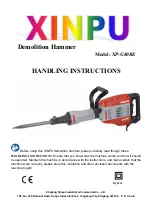
6
Supplying with energy
6.1 Battery care
In order to obtain the full performance, lithium-ion batteries (Li-Ion)
require care.
n
The first charging process is crucial. Charge the battery fully
prior to first use.
n
Each battery has a limited number of charge cycles. For this
reason, do not recharge the battery at every opportunity.
Instead, wait until a charge status of between 10% and 20%
capacity before recharging.
n
If the battery is discharged below its nominal voltage, the battery
could be damaged or destroyed. The batteries included in the
delivery therefore have electronics that warn of deep discharge
and switch off the nutrunner.
n
Frequent overcharging can cause permanent damage to the
battery. The charger automatically concludes the charging
process if the battery is fully charged. Do not connect the bat-
tery again.
n
The battery can only be charged at temperatures between 5°C
and 45°C. To avoid damaging the battery cells, do not charge
the battery when it is cold. Let it warm up to room temperature
beforehand. Charge the battery at room temperature (18°C to
21°C).
n
High temperatures damage the battery. Never leave the battery
or the transport case in the car or in the sunshine on hot days.
The lithium-ion battery loses capacity and performance capa-
bility at temperatures above +60°C.
n
Do not store lithium-ion batteries empty or fully charged for a
prolonger period of time. Optimum storage at a capacity of 40%
to 50% and at temperatures of 5°C to 10°C.
n
Store unused batteries in a cool but not cold location. Batteries
also lose energy in an unused state. The energy loss for lithium-
ion batteries is approx. 3% to 5% per month.
n
If a lithium-ion battery is not used for a prolonger period of time,
recharge the battery after 12 months at the latest.
n
Always dispose of old and used batteries in an environmentally
sound manner.
Optimum storage temperature: 5°C to 10°C.
Lithium-ion batteries (Li-Ion) should not be stored empty or fully
charged for a prolonged period of time. Optimum storage, which
was determined in an extensive series of tests, is at 40% to 50% of
capacity and at low temperatures, but not below 0°C. Due to self-
discharge, recharging is required every 12 months at the latest.
Disconnect the battery from the nutrunner if the nutrunner will not
be used for a prolonged period of time.
Battery care instructions
Battery care rules
Storing the battery
Battery not in use for a prolonged
period of time
Supplying with energy
43
Содержание DP05-34B
Страница 1: ...Operating instructions Read the manual carefully before use Keep for future use...
Страница 2: ......
Страница 4: ......
Страница 66: ...NOTES...
Страница 67: ......
Страница 68: ......
















































